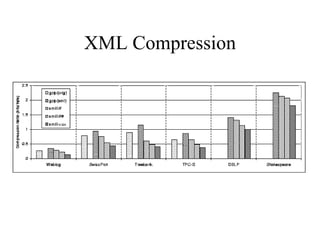19compression
- 1. Managing XML and Semistructured Data Lecture 19: Compressing XML Data Prof. Dan Suciu Spring 2001
- 2. In this lecture XML Compression Motivation XMill approach and results Resources XMILL: An Efficient Compressor for XML Data by Liefke and Suciu, in SIGMOD'2001
- 3. Compression: The Problem XML for exchange (space or time) but XML is verbose users prefer application specific formats: Web Server Logs EMBL G2 is XML doomed to fail ?
- 4. An Example:Web Server Logs < apache:entry > < apache:host > 202.239.238.16 </ apache:host > < apache:requestLine > GET / HTTP/1.0 </ apache:requestLine > < apache:contentType > text/html </ apache:contentType > < apache:statusCode > 200</ apache:statusCode > < apache:date > 1997/10/01-00:00:02</ apache:date > < apache:byteCount > 4478</ apache:byteCount > < apache:referer > http://www.net.jp/ </ apache:referer > < apache:userAgent > Mozilla/3.1$[$ja$]$(I)</ apache:userAgent > </ apache:entry > 202.239.238.16|GET / HTTP/1.0|text/html|200|1997/10/01-00:00:02|-|4478|-|-|http://www.net.jp/|Mozilla/3.1[ja](I) ASCII File 15.9 MB (gzipped 1.6MB): XML-ized inflates to 24.2 MB (gzipped 2.1MB):
- 5. XMill specialized compressor for XML data makes XML look “small” Download: Now: www.research.att.com/sw/tools/xmill Soon: www.cs.washington.edu/homes/suciu/XMILL
- 6. How Xmill Works: Three Ideas < apache:entry > < apache:host > </ apache:host > . . . </ apache:entry > 202.239.238.16 GET / HTTP/1.0 text/html 200 … gzip Structure gzip Data =1.75MB + Compress the structure separately from the data:
- 7. How Xmill Works: Three Ideas < apache:entry > . . . </ apache:entry > 202.23.23.16 224.42.24.55 … gzip Structure gzip Data1 =1.33MB + GET / HTTP/1.0 GET / HTTP/1.1 … gzip Data2 + Group the data values according to their types:
- 8. How Xmill Works: Three Ideas Apply semantic (specialized) compressors: Examples: 8, 16, 32-bit integer encoding (signed/unsigned) differential compressing (e.g. 1999, 1995, 2001, 2000, 1995, ...) compress lists, records (e.g. 104.32.23.1 4 bytes) Need user input to select the semantic compressor gzip Structure + gzip c1(Data1) + gzip c2(Data2) + ... =0.82MB
- 11. Summary of XML Data Management XML = old data type (trees) with new interpretation (data) We discussed traditional management techniques for XML: Data model Query language Optimizations ... Many traditional problems still unsolved (storage, processing, optimization, ...)
- 12. Summary of XML Data Management More interesting question: what are the novel applications enabled by XML ? Some ideas: Approximate queries over unfamiliar data instances “ Search the database for a pattern similar to this one” Rank results based on their similarity to the pattern What is an appropriate query language for that ? Linking independent databases We have Xlink, how do we use it ?



![An Example:Web Server Logs < apache:entry > < apache:host > 202.239.238.16 </ apache:host > < apache:requestLine > GET / HTTP/1.0 </ apache:requestLine > < apache:contentType > text/html </ apache:contentType > < apache:statusCode > 200</ apache:statusCode > < apache:date > 1997/10/01-00:00:02</ apache:date > < apache:byteCount > 4478</ apache:byteCount > < apache:referer > http://www.net.jp/ </ apache:referer > < apache:userAgent > Mozilla/3.1$[$ja$]$(I)</ apache:userAgent > </ apache:entry > 202.239.238.16|GET / HTTP/1.0|text/html|200|1997/10/01-00:00:02|-|4478|-|-|http://www.net.jp/|Mozilla/3.1[ja](I) ASCII File 15.9 MB (gzipped 1.6MB): XML-ized inflates to 24.2 MB (gzipped 2.1MB):](https://image.slidesharecdn.com/19compression-1202767118188427-4/85/19compression-4-320.jpg)







